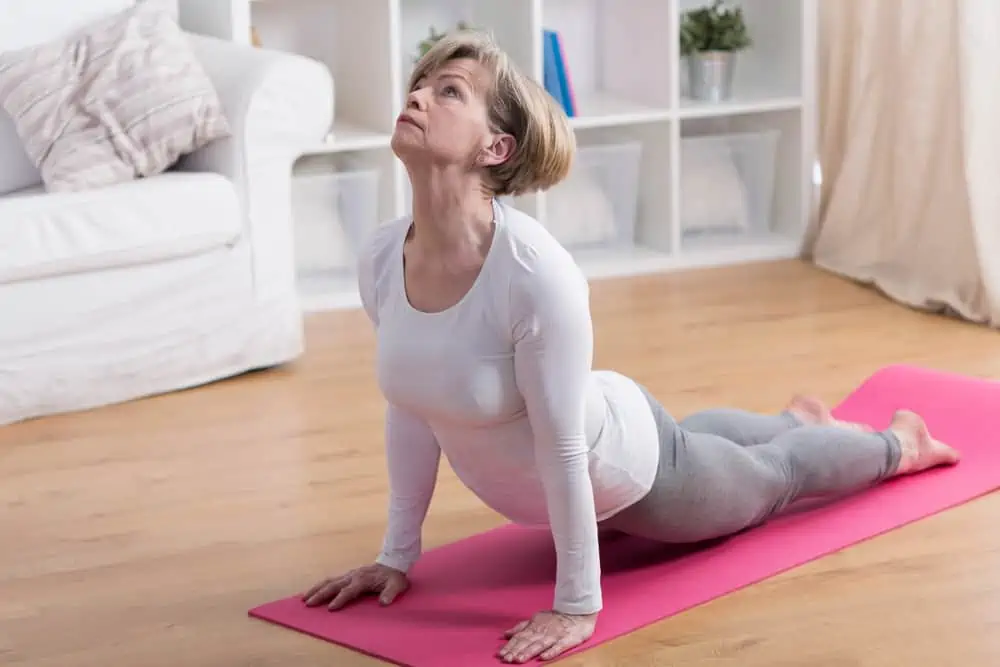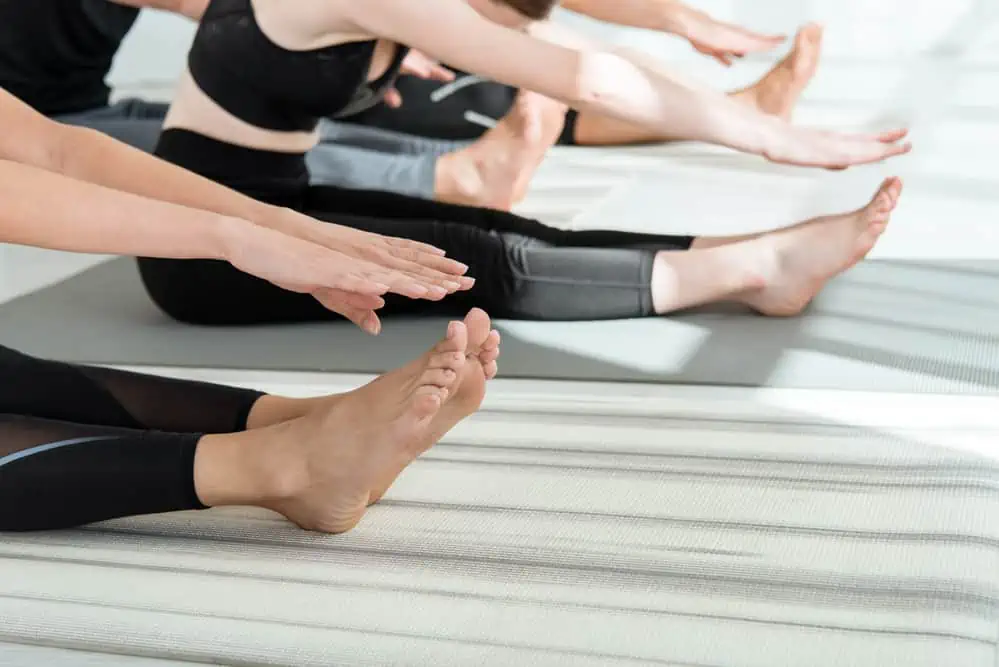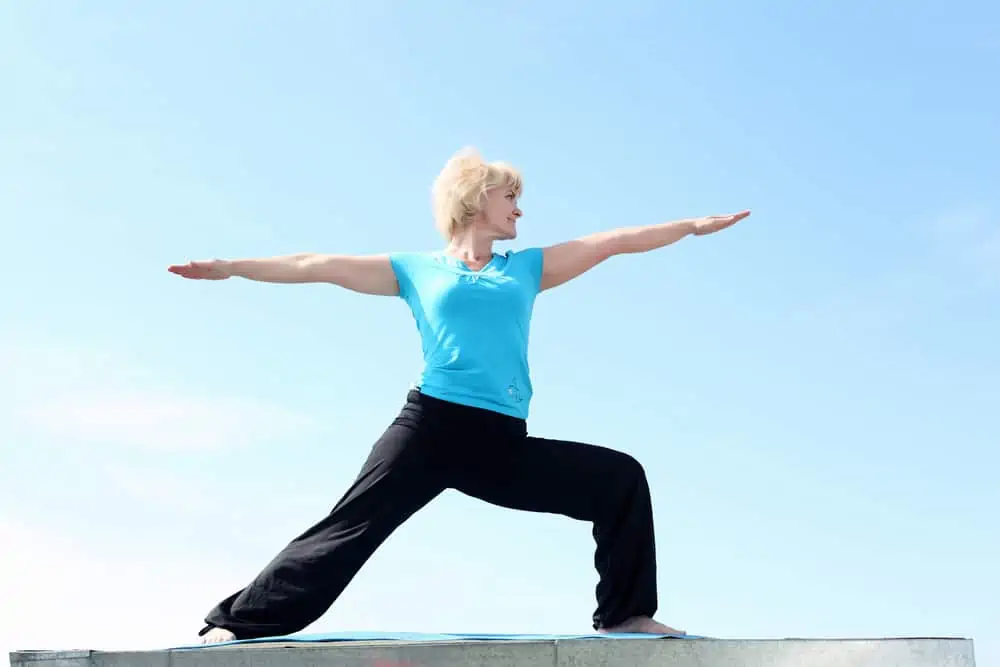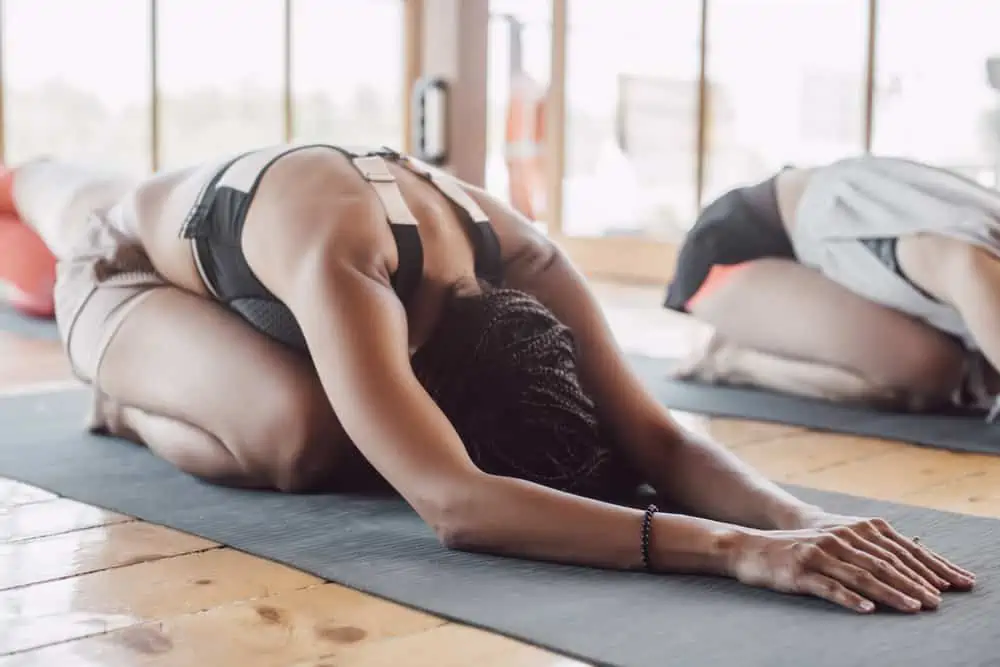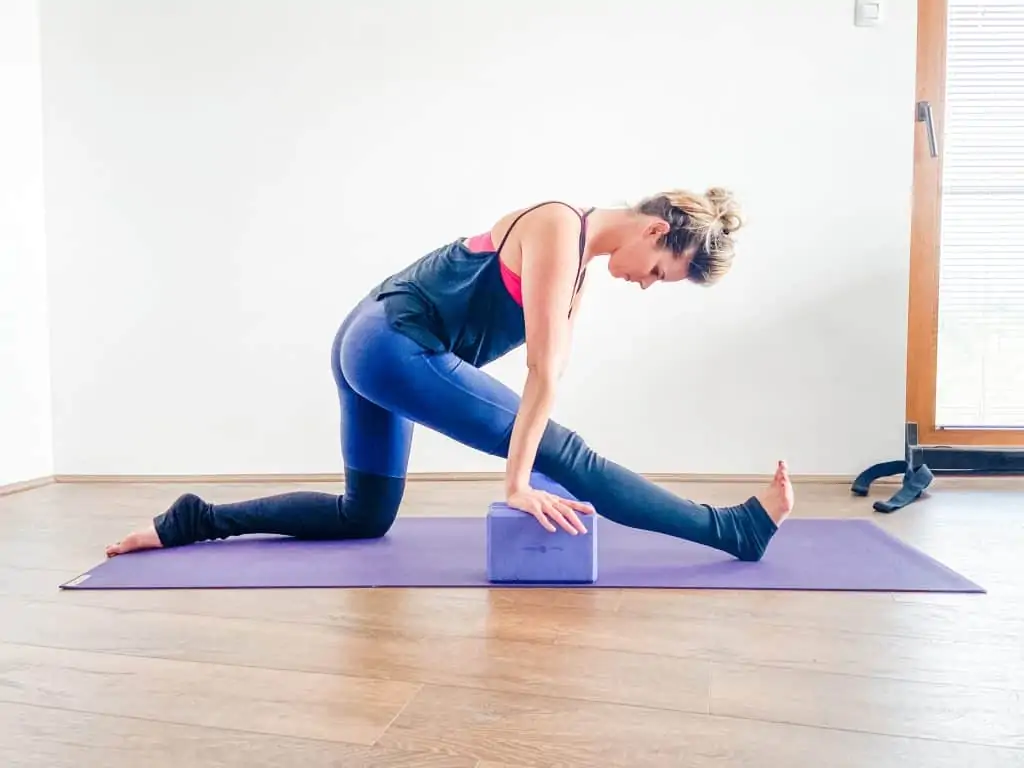This post may contain affiliate links. If you click through a link and make a purchase, I may receive a commission at no additional cost to you. As an Amazon Associate, I earn from qualifying purchases. Read the full disclosure here.
Weight-bearing exercise is promoted as an important component of staying healthy with osteoporosis.
Does yoga count as weight-bearing exercise? Is yoga bad for osteoporosis? These are common questions people consult Dr. Google for.
Here’s the quick answer – yoga can be a beneficial part of a well-rounded exercise routine for someone with osteoporosis, however, there are some specific yoga poses that are not always safe.
Keep reading to learn which yoga poses to avoid with osteoporosis to keep yourself safe.
Disclaimer: This content is for educational purposes and is not medical advice. Read the full disclaimer.
What is osteoporosis?
Osteoporosis (literally translated to porous bone) is a condition defined by low bone density.
This decreased density affects the structure of the bone tissue and predisposes patients to low-impact fragility fractures (meaning, you can fracture a bone with minimal effort), such as when lifting, coughing, or sneezing.
According to the Bone Health & Osteoporosis Foundation (formerly the National Osteoporosis Foundation), approximately one in two women and up to one in four men age 50 and older will break a bone due to osteoporosis.
The most common areas of the body to experience osteoporosis fractures are the spine, hips, and wrists.
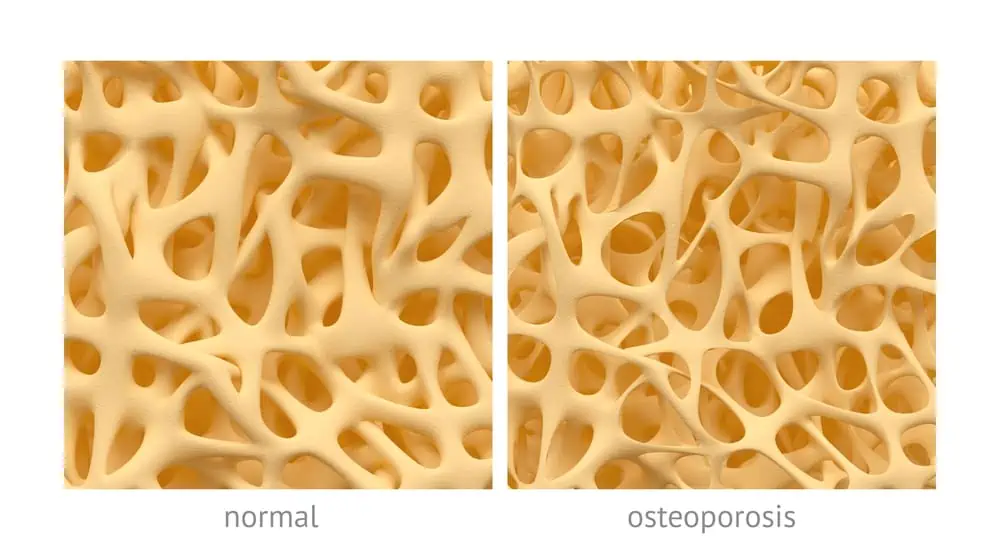
Calcium and vitamin D aren’t the only things you can do in your quest for healthy bones. Muscle strength also plays a key role.
Physical inactivity is considered to be a modifiable risk factor for developing osteoporosis. Promoting strength, weight-bearing exercise, and balance are encouraged in the treatment of osteoporosis to build healthy bone.
Strengthening exercises help osteoporosis because contracting muscles places strain on the bones, stimulating bone growth and ultimately improving bone strength to become more resistant to fractures.
Yoga can be a part of a well-rounded fitness program with osteoporosis providing benefits of body weight strengthening and balance in addition to flexibility and stress relief. Yoga may also improve movement and postural awareness.
A very small study published in 2016 by Lu YH et al. demonstrated an improvement in bone mineral density in the spine and femur (after 1 or more years) with participants performing a specific 12-minute yoga program daily. The poses were specifically selected for straining certain tissues in the spine and hips and are known to become weakened.
The catch is that the people who saw the most improvement were consistent with the daily program, but also were performing relatively higher levels of each pose. (Translation, you can’t just take any 12 minute yoga program and expect the same results.)
Another study published in 2021 (systematic review and meta-analysis, which looks at multiple studies) found no significant improvement in bone mineral density with interventions including yoga and Pilates.
Their positive spin on this was that while the density didn’t improve, it also didn’t get significantly worse. There were also some limitations with the available studies.
Osteoporosis vs. osteopenia
Osteopenia is defined as low bone mass but is not as severe as osteoporosis.
It’s important to start strengthening exercises as early as possible to defend against these two conditions to prevent bone loss.
Yoga poses to avoid with osteoporosis
People with osteoporosis are more prone to low-impact fragility fractures, meaning they can fracture a bone with very little effort. The most vulnerable areas to experience a fracture due to osteoporosis are the spine, hips, and wrists.
This is, of course, a general outline of poses that could be risky for osteoporosis. There are several individual factors such as severity of osteoporosis and level of experience and comfort with each pose that should be taken into account.
Vertebral body fractures (spinal fracture) occur with forceful or prolonged flexion (rounding the back). Yoga poses that promote spinal flexion such as seated forward fold may present a risk of compressing the vertebral bodies, especially if there is already a thoracic kyphosis (C curvature of the spine when looking from the side).
Many yin yoga poses also promote spinal flexion and should be avoided with osteoporosis. Check out this article written by Margaret Martin, a fellow physical therapist and yoga teacher outlining safe and unsafe yin yoga poses for osteoporosis.
Avoid forceful extension of the spine as this places stress on the facet joints of the spine. Upward dog or camel may be too aggressive for an osteoporotic spine, however, cow and sphinx are less forceful and still allow for the promotion of spinal extension.
Also, consider more gentle versions of your favorite spinal twists and side bends. Take a second to lift and lengthen before twisting or bending to reduce further compression.
If you already have a strong inversion practice, poses to continue performing should be a discussion between you and your doctor. Poses such as headstands have an increased risk of falling and increased pressure through the cervical spine. Again, this is dependent on your level of experience and severity of osteopenia/osteoporosis.
If you don’t have a regular inversion practice, starting one now would probably pose more risk than benefit. There are still many gentle inversions (such as legs up the wall or supported bridge) to provide inversion benefits without the fall risk or strain on tissues.
As for the hips, caution placing a lot of torque through the neck of the femur in poses like shoestring, firelog, or even pigeon. Utilize blocks and straps to help maintain alignment while stretching or choose more gentle versions like reclined pigeon.
The wrists are another vulnerable area with osteoporosis. This is usually due to catching oneself from a fall, however, the wrists take a lot of pressure during some arm balance poses. Your choice to perform these poses or not will be individual to you and your experience level.
Reduce the risk for falls and have a sturdy chair or ballet barre nearby for balance to help with certain standing poses. This chair is a neat option because the back has been removed to allow for more space to perform yoga poses with support.
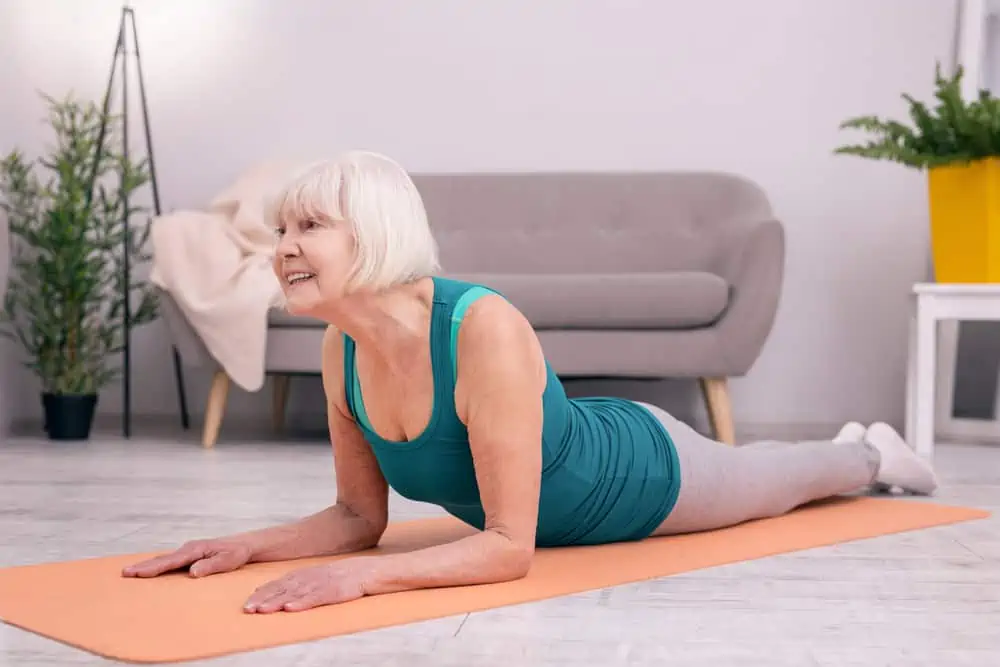
Weight-bearing exercise vs. strengthening
Both weight-bearing and strengthening are terms used to describe beneficial exercise for osteoporosis.
Weight-bearing exercise involves any exercise in which you’re supporting your weight on your bones. This may include walking, low-impact aerobics, or gardening. Strengthening can be weight-bearing, but not all weight-bearing exercise is strengthening.
Strengthening involves loading your bones, muscles, and other connective tissues to make them stronger.
To see a measurable improvement in strength and bone mineral density, Hong AR and Kim SW cite that bone tissues must be exposed to mechanical load exceeding those experienced during daily living activities.
While yoga does have some elements of body weight strengthening, there is a limit to what it can provide and there are many benefits of adding a separate strengthening program off the mat.
Does yoga count as weight-bearing exercise?
As far as yoga, it depends on the type of yoga you’re doing. Standing postures such as chair, warrior 1, or warrior 2 have a strong body weight strength component. Other postures such as downward dog and plank have weight-bearing and strengthening for the upper body and core.
Seated or lying down poses, while they have other benefits, do not carry the same weight-bearing benefits.
While yoga has some elements of body weight strengthening, yoga isn’t a one-stop-shop for all your fitness needs. If you’re serious about using exercise to maximize bone density benefits in the fight against osteoporosis, it’s good to consider other types of resistance training.
What styles of yoga are safe for osteoporosis?
If you are an experienced yogi, your approach to tailoring your practice will look different than someone who is just starting out. Even if you regularly participate in more vigorous styles of yoga, you may choose to omit or modify certain poses. It depends on a number of individual factors.
If you already have osteoporosis and are looking to start yoga, try slower-paced styles such as Hatha, slow Vinyasa, restorative, or modified yin yoga.
Focus on promoting length, space, strength, and stability over forcing yourself into a particular shape. If you’re unsure of what your limitations are medically, speak with your doctor.
Always let your instructor know if you have osteoporosis or other medical concerns that may affect what yoga postures are risky for you.
Safety tips for yoga with osteoporosis
Educating yourself is one of the most critical aspects of prevention and management of osteoporosis.
Here are some safety tips for osteoporosis to help you become your own advocate while incorporating yoga into your routine. These tips are also helpful for Pilates and barre fitness programs as the general precautions will be the same.
- If you’ve been diagnosed with osteoporosis, speak with your doctor to decide if starting an exercise program is right for you. However, do keep in mind that not every doctor or physical therapist will understand the specifics of yoga movements. If this is the case, ask specifically which movements to avoid.
- Always let your instructor know about injuries or medical conditions ahead of time.
- Learn what a neutral spine feels like and aim to maintain a neutral spine and decrease flexion stress on the spine.
- Understand the difference between flexing at the hip and rounding the spine.
- Avoid extreme range of motion in any plane.
- Prioritize posture, breathing, and control over further range of motion.
- Take advantage of props to help you access poses in a safer range of motion.
- Use a mat with extra padding or double two yoga mats to prevent excessive pressure on the spine.
- Avoid unsupported supine positions if there is significant kyphosis curvature in the thoracic spine (upper back hump) – opt for leaning on the forearms or use pillows/bolsters to support the spine and avoid excessive pressure.
- Avoid falls and reduce the risk of bone fracture by utilizing a chair or ballet barre for additional support if you feel unsteady with standing exercises.
I also recommend checking out the book Exercise For Better Bones – A Complete Guide to Safe and Effective Exercises For Osteoporosis written by physical therapist Margaret Martin. The book outlines safe exercises for people with osteoporosis of all fitness levels.
You can also seek out osteoporosis exercise classes, a personal trainer with training in working with clients who have osteoporosis, or a program designed by a physical therapist with experience in managing osteoporosis.
Is yoga bad for osteoporosis?
No, yoga is not bad for osteoporosis; however with any exercise program for osteoporosis, one needs to keep a few precautions in mind for safety. Learn which compromising poses increase the risk for a fracture and tailor your practice to fit your needs.
When it comes to exercise for osteoporosis, there isn’t really a one size fits all approach. There’s a lot of variability in choosing the right strengthening and weight-bearing exercises that fit your lifestyle both on and off the mat.
References
Carter MI, Hinton PS. Physical activity and bone health. Mo Med. 2014 Jan-Feb;111(1):59-64. PMID: 24645301; PMCID: PMC6179512.
Hong AR, Kim SW. Effects of Resistance Exercise on Bone Health. Endocrinol Metab (Seoul). 2018 Dec;33(4):435-444. doi: 10.3803/EnM.2018.33.4.435. PMID: 30513557; PMCID: PMC6279907.
Lu YH, Rosner B, Chang G, Fishman LM. Twelve-Minute Daily Yoga Regimen Reverses Osteoporotic Bone Loss. Top Geriatr Rehabil. 2016 Apr;32(2):81-87. doi: 10.1097/TGR.0000000000000085. Epub 2015 Nov 5. PMID: 27226695; PMCID: PMC4851231.
Motorwala ZS, Kolke S, Panchal PY, Bedekar NS, Sancheti PK, Shyam A. Effects of Yogasanas on osteoporosis in postmenopausal women. Int J Yoga. 2016 Jan-Jun;9(1):44-8. doi: 10.4103/0973-6131.171717. PMID: 26865770; PMCID: PMC4728958.

